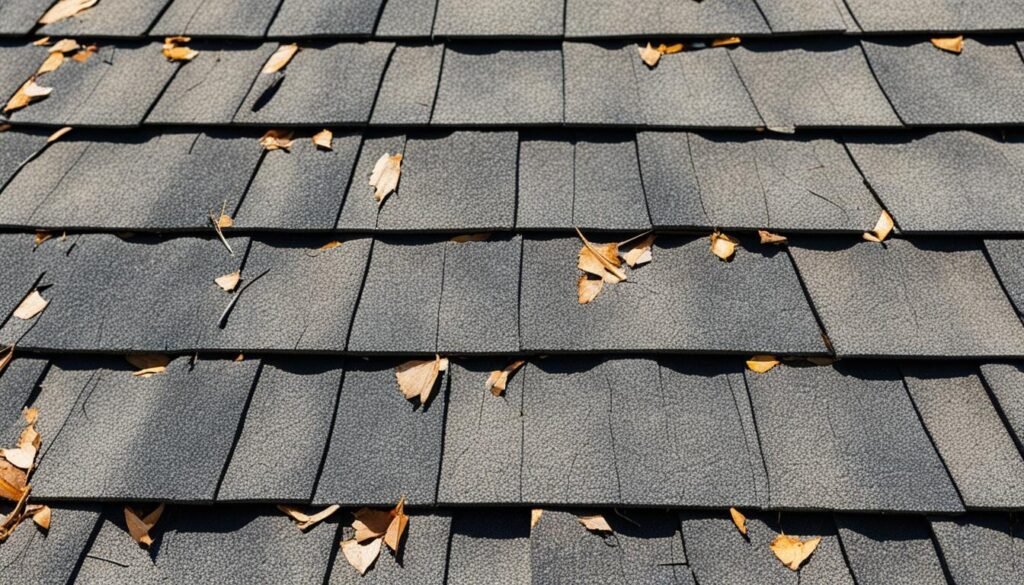Over 75% of US homes have asphalt shingle roofs. Even though they are tough, they can still get damaged. It’s crucial for homeowners to check their roofs often. This can help catch problems early, preventing costly water damage and other issues.
Key Takeaways
- Asphalt shingles typically last 15-30 years, but can suffer damage from storms, impact, or aging.
- Missing, bruised, or cracked shingles are common signs of shingle damage that require attention.
- Blistering, cupping, and granule loss are also indicators of shingle deterioration.
- Neglecting roof shingle repairs can lead to water damage and further costly problems.
- Regular inspections and prompt repair of damaged shingles can help extend the life of your roof.
Identifying Common Signs of Shingle Damage
Asphalt shingles keep your house safe from rough weather. Sometimes, even the toughest roofs face trouble. It’s smart to check your roof often, especially after storms, for signs like missing shingles or exposed spots that might need fixing.
Missing Shingles
Big storms can tear shingles right off. This leaves the underlayment open to water and more damage. Quick action to cover these spots stops shingle damage and leaks. Making a habit of checking for missing shingles helps you protect your home.
Bruised and Cracked Shingles
Hail or rocks hitting your roof can bruise or crack shingles. This damage is easy to spot: look for darker areas or visible breaks. If you see them, it’s important to act fast. Making timely fixes keeps your roof strong against the next storm.
Your shingles might last 20 to 30 years, but they can still get hurt as they get older. Bad weather is a big threat. To keep your roof healthy and your house dry, regular checks and quick repairs are necessary. This protects your home from the elements.

Additional Indicators of Bad Asphalt Shingles
Watching your roof’s conditions is crucial as it gets older. Look out for signs like blistering, cupping, and granule loss. These issues can weaken your roof, risking leaks and water damage in your home.
Blistering and Cupping
Blistered shingles lose granules in spots, showing the asphalt underneath. This makes them prime for UV damage. Such blistering appears because of extreme heat, poor ventilation, or wrong ways of being put in place.
Cupped shingles have centers that dip or edges that rise. This causes water to sit on the roof. It could also lead to leaks and water damage.
Granule Loss
Older asphalt shingles start dropping their granules. You might find these in gutters or on the ground. Losing these granules puts the shingles at risk from UV damage, aging faster, and causing more leaks. If you see a lot of granules missing, think about a roof replacement.
| Symptom | Cause | Potential Consequences |
|---|---|---|
| Blistered Shingles | Excessive heat, poor ventilation, improper installation | Increased UV damage, accelerated aging |
| Cupped Shingles | Improper installation, normal aging | Water pooling, potential leaks and water damage |
| Granule Loss | Normal aging, exposure to elements | Increased UV damage, accelerated aging, risk of leaks |
Always keep a close watch on your roof. Take care of these problems early to make your shingles last longer. This will save you from dealing with expensive shingle deterioration and water damage.

Conclusion
Regularly check your asphalt shingle roof. Look for missing, bruised, or cracked shingles, and other signs of damage. By doing this, you can catch problems early and avoid expensive repairs. If you spot any shingle issues, call a professional roofing contractor like Local Roofer Pros. They’ll guide you on what to do next.
Asphalt shingle roofs are common in Mid Missouri and across the US. They offer a budget-friendly and long-lasting roof choice for most people. But, you must take care of them to ensure they last 20 to 30 years. Watch out for signs of shingle damage and take action quickly. This will help extend the roof’s life and keep your home safe from leaks.
Asphalt shingles have both good and bad points. They can be damaged by wind and weather and may develop algae or mold. A trusted roofing contractor can help you create a solid maintenance plan. This plan will tackle problems effectively and ensure your roof lasts for years.
FAQ
What are the warning signs of bad asphalt shingles?
How can missing shingles impact my roof?
What do bruised and cracked shingles indicate?
What are the signs of blistering and cupping in asphalt shingles?
How can I tell if my asphalt shingles are losing granules?
Source Links
- https://jdhostetter.com/6-common-signs-your-asphalt-shingles-are-damaged/
- https://rooflux.com/6-serious-warning-signs-your-asphalt-shingled-roof-needs-repair/
- https://dryforcecorp.com/7-signs-of-damage-to-your-asphalt-shingles-and-roof/
- https://www.ableroof.com/blog/10-signs-shingle-damage/
- https://fiveguysroofing.com/roof-shingles-woes-identifying-common-problems-and-solutions/
- https://www.gaf.com/en-us/plan-design/homeowner-education/do-i-need-a-new-roof
- https://www.smartextpros.com/6-signs-your-asphalt-shingles-are-damaged/
- https://www.christianbrothersroofingllc.com/6-common-signs-your-asphalt-shingles-are-damaged/
- https://www.barnettroofingknoxville.com/blog/signs-of-poor-asphalt-shingle-roofing-installation/
- https://comoexteriors.com/what-are-the-pros-and-cons-of-asphalt-shingle-roofing-columbia-mo/
- https://www.proaccessroofing.com/r-asphalt-shingles-review-pros-cons-and-cost-expert-insights-on-asphalt-shingle-roofs
- https://www.allin1roofs.com/pros-and-cons-of-asphalt-shingle-roofing/
